Some Christians believe* that American law is based on biblical law. One of their evidences is the claim that Moses and the Ten Commandments are prominently featured at the United States Supreme Court.But . . .
Did you know that there is nothing in the design of the United States Supreme Court building that would indicate that the Congress, architect or designers had any special regard for the Ten Commandments?
Did you know that the main entrance to the United States Supreme Court has no reference to religion
or the Ten Commandments?

Did you know that those large statues beside the steps do not represent any religious figures or concepts?
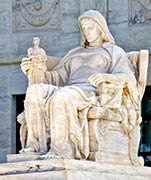
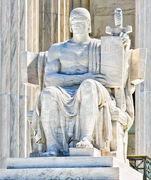
Did you know that the sculptor, James Earle Fraser, considered those to be allegorical human figures? He described “Contemplation of Justice” (on the left, holding a smaller figure of blindfolded Justice) as “a realistic conception of what I consider a heroic type of person with a head and body expressive of the beauty and intelligence of justice.” He described “Authority of Law” as “powerful, erect, and vigilant. He waits with concentrated attention, holding in his left hand the tablet of laws, backed by the sheathed sword, symbolic of enforcement through law.”
Did you know that the Ten Commandments expressly forbid the creation of such graven images?

Exodus 20:4
Did you know that the carved figures at the Supreme Court would be considered a form of idol worship under the Ten Commandments?
Did you know that this is one of many evidences that American law ignores the authority of the Hebrew scriptures?
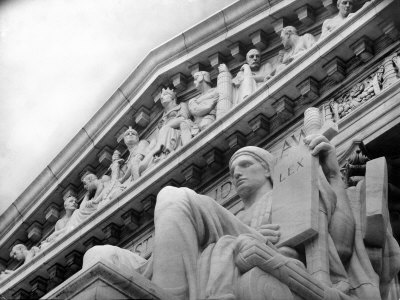
Authority of Law
Did you know that the tablet held by “Authority of Law” does not represent the Ten Commandments? (The Ten Commandments are usually depicted by two tablets and Hebrew lettering.) The Latin word LEX (“law”) in this context refers to law in general.

Did you know that the words “Equal Justice Under Law” (approved by Chief Justice Charles Evans Hughes) that appear above the steps to the Supreme Court are not a quote from any religious teaching, but a uniquely American phrase? It is taken from a sentence that appeared in the 1891 Caldwell v. Texas Supreme Court decision, which ruled that all citizens, under the Due Process clause of the 14th Amendment, are entitled to “equal and impartial justice under the law.” This principle is found nowhere in Judeo-Christian scripture. Did you know that if the Ten Commandments were the basis of law, there would be no “equal justice” for nonbelievers or followers of other religions?
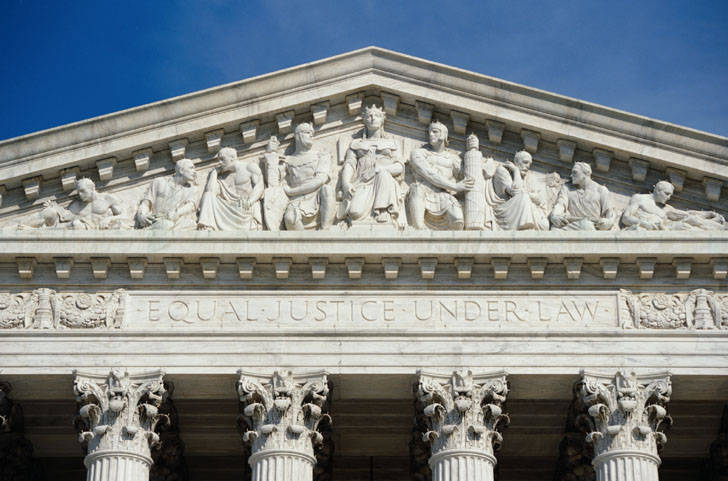
Western pediment
Did you know that the carvings above the main entrance to the Supreme Court represent no religious figures or teachings? Five characters are allegorical: Liberty (in the middle, with the scales of justice, a symbol that originated in Babylonia and Egypt and predated the writing of the Ten Commandments), Order, Authority, and two figures representing Council. The remaining individuals are candidly historical: Chief Justice William Howard Taft, Senator Elihu Root, architect Cass Gilbert, Chief Justice Charles Evans Hughes, the sculptor Robert Aitken, and Chief Justice John Marshall.

Robert Aitken
Did you know that Robert Ingersoll Aitken, the sculptor (whose namesake may have been the famous agnostic orator Robert Ingersoll), put himself into the Western Pediment (second from right)? Whatever his personal views were, do you think that because Aitken’s figure appears at the Supreme Court, American law is based on the views of Robert Aitken?
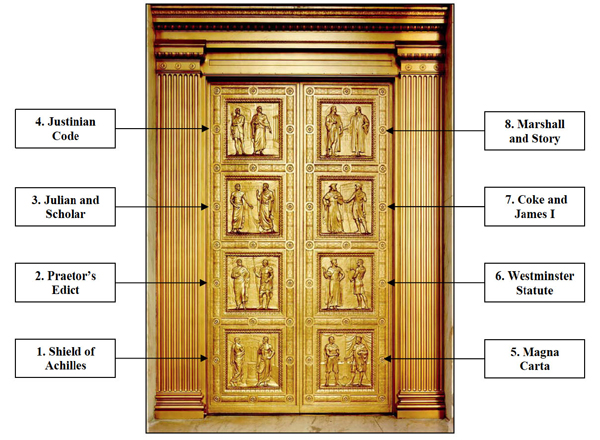
Front door of the Supreme Court
Did you know that the bronze doors at the front of the building, leading into the courtroom, contain no references to religion? (See footnote about Julian)
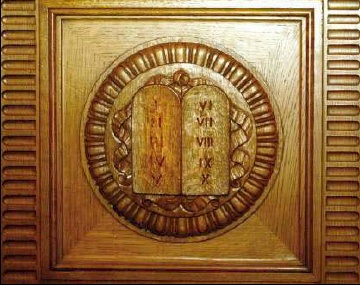
Inside door at the Supreme Court
Did you know that the official guides to the Supreme Court building explain to visitors that the Roman numerals I-X on the inner oak door of the Supreme Court refer to the Ten Amendments of the Bill of Rights (and not to the Ten Commandments)?
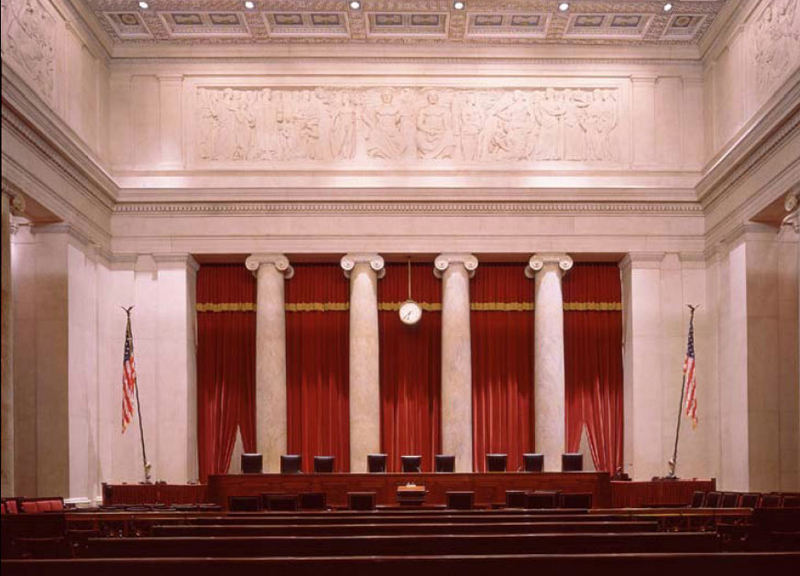
Courtroom
Did you know that the frieze on the wall above where the Supreme Court judges sit, depicting a seated figure beside a tablet with the Roman numerals I-X, does not represent Moses or the Ten Commandments?

East frieze, above the justices
Some believers mistakenly assume those are the Laws of Moses in the middle of the frieze. They forget that Moses reportedly had two tablets, that there would be no sun or eagle on top of the Ten Commandments, and that the Roman numbering system was not invented at the time the Hebrew scriptures were written.
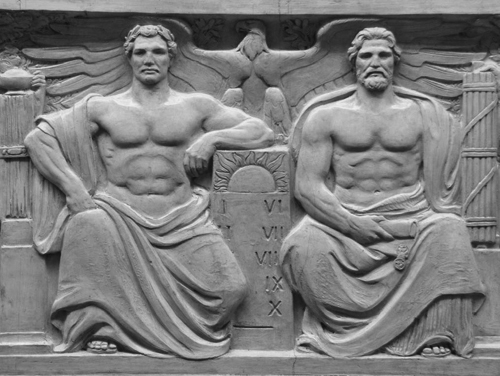
Did you know that the designer of that frieze, Adolph Weinman, wrote a letter to the architect explaining that this graven image represents the “Majesty of the Law,” sitting beside the “Majesty of Government,” and that the Roman numerals I-X stand for the ten amendments of the Bill of Rights? [That letter is on file in the archives of the Supreme Court. It is unsigned because it was probably a copy for record-keeping.]
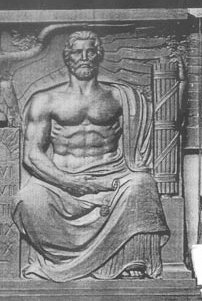
Did you know that the “Majesty of Government” image to the right of the tablet is holding an ancient fasces (bundle of sticks) in his left arm? The fasces represented Roman law and authority and was carried much like the American flag is carried today. Since that image sits directly above the heads of the nine Justices (and another above the main entrance), do you think American law is based on the Roman fasces?

West frieze

South frieze
Did you know that although Moses is depicted inside the Supreme Court (fourth from left on the south frieze), he is not the central figure, but merely one of many “great lawgivers of history” on the South and North walls? Weinman placed Moses somewhat off to the side on the South frieze (not above where the justices are seated). Moses (holding two tablets) is standing among other allegedly historical lawgivers such as Menes (holding an Egyptian ankh), Hammurabi (who allegedly received his laws from the Babylonian Sun God), Solomon (who was wise enough to manage 700 wives and 300 concubines), Solon, the legendary Lycurgus (the central figure, who consulted the Oracle at Delphi), Draco, Confucius, Octavian, Justinian, Muhammad (the polygamist who claimed to have received Islamic law from the god Allah), Charlemagne, King John, the Crusader Louis IX (“Saint Louis”), Hugo Grotius, Sir William Blackstone, John Marshall, and Napoleon, as well as allegorical or mythical lawgivers such as the Greek goddess “Fame,” the Egyptian goddess “Authority,” the “Light of Wisdom” goddess, “Equity,” “Philosophy” and “History.”
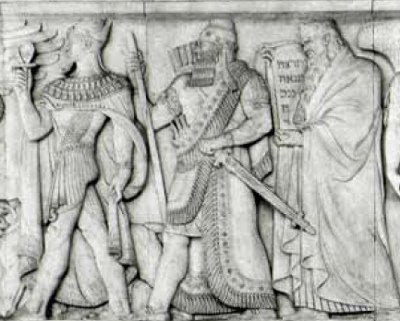
Detail of Menes, Hammurabi and Moses, south frieze
Do you see that Moses is walking behind (not leading) Menes and Hammurabi in the south frieze? Menes was an Egyptian pharaoh and Hammurabi was a Babylonian king, both of whom worshipped a sun god.

North frieze
Did you know that it was the designer, not Congress, who chose what images to represent on those friezes?
If the Ten Commandments were truly the basis of American Law, then why is Moses merely one of the throng of many lawgivers, real, legendary and allegorical? Since the other characters have as much prominence as Moses, why not consider American law to be based on the Greek Oracles of Delphi, or the sun gods of Mesopotamia and Egypt, or a book of philosophy, or the Koran?
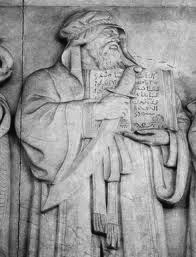
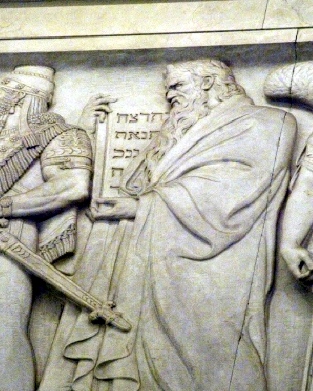
Did you know that Muhammad and Moses stand almost directly opposite each other on the South and North walls, appearing somewhat off to the side on each frieze, and seem to be on par with each other?

Did you know that the lettering on the tablet shown with Moses represents fragments of Hebrew words from only the last five Commandments?
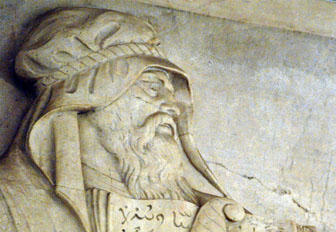
Did you know that Muhammad is also depicted holding a so-called holy book?
Did you know that image contains Arabic letters from the Koran?
Do you think the artistic depiction of the words of a holy book at the Supreme Court make that book the basis for American law? If the Ten Commandments are the basis of American law because they appear in the Supreme Court, then why not the Koran? Or why not Roman law, since “LEX” appears at the front entrance?





Egyptian ankh, book of philosophy, owl, pagan lamp of wisdom, pagan scales of justice
Did you know that the artistic representation of the Ten Commandments tablets is only one of many other historical, religious, and mythical symbols that appear on those friezes? These mainly pagan symbols include or represent: the Egyptian ankh, the Roman fasces, a mirror, a rose, more than ten representations of the scales of justice, a dove, an owl (a symbol of wisdom in Greek, Roman, Indian and other pagan cultures, but not the Bible), harp, Greek scrolls of law, a book of philosophy, the Magna Carta, the Justinian code, an orb, the sword of a Crusader, at least eight more swords, more than one lamp, a scepter, and many other historical as well as mythical items?
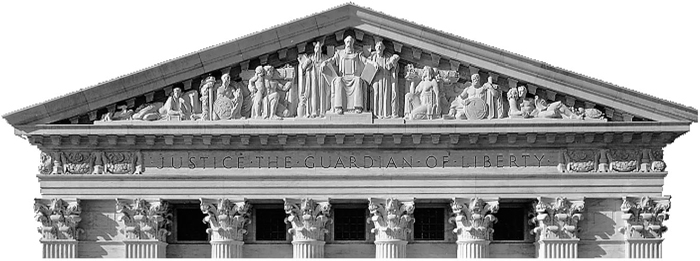
Eastern pediment (back of the building)
Did you know that while Moses is indeed depicted twice at the Supreme Court (outside and inside), so are Confucius and Solon? Moses is the central figure on the eastern pediment, the back of the building that few people see, facing away from the nation. Although Moses is central, certainly due to the fact that most European settlers of America came from a Judeo-Christian heritage, neither Confucius nor Solon are secondary in that image.
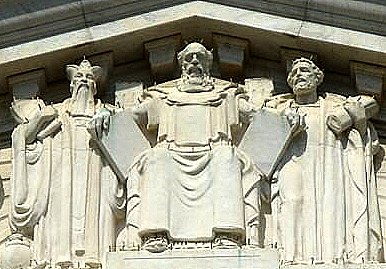
Confucius, Moses and Solon, Eastern pediment
Did you know that the designer of that eastern pediment gave secular reasons for that art? Sculptor Herman A. MacNeil wrote: “Law as an element of civilization was normally and naturally derived or inherited in this country from former civilizations. The ‘Eastern Pediment’ of the Supreme Court Building suggests therefore the treatment of such fundamental laws and precepts as are derived from the East.” Neither Congress nor the sculptor claimed that American law is based on Confucius, Solon, or Moses. They merely acknowledge the unsurprising fact that American civilization, like all cultures, had many historical antecedents, having been settled by people from all over the world.
Do you see that the pediment that is looking backward (to the east) contains Moses and myth while the pediment that is looking forward (west, above the main entrance facing the nation) contains no religious images?

Did you know that eastern pediment with Moses in the center is flanked by the Tortoise and the Hare from Aesop’s Fables? Those two fictional animals face Confucius, Moses, and Solon from either side.
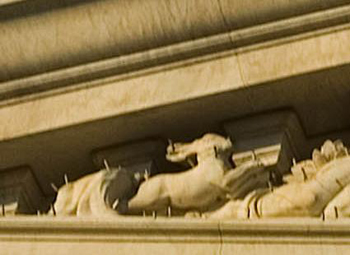

Hare and Tortoise from Aesop’s Fables, Eastern Pediment
Do you think American Law is based on Aesop’s fables?
Do you think any story that personifies animals (such as a talking snake) can be the basis for law?
Do you think that the fact that any particular image (such as Moses) appears at the Supreme Court is evidence that American laws were based on that character?
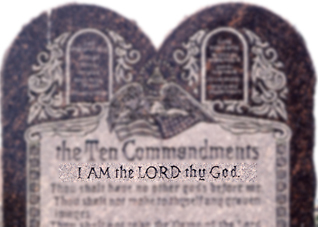
Did you know that the purpose of the Ten Commandments was to establish the ancient nation of Israel, not the nation of the United States? Did you know that the purpose of the First Commandment was to declare which god among many (Elohim) was to be worshipped by the nation of Israel?
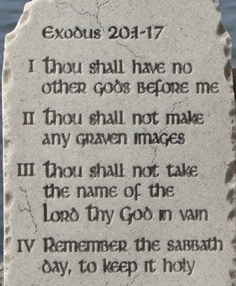
Did you know that the first four Commandments have nothing to do with law or ethics?
They are religious edicts.
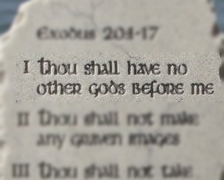
Did you know that the First Commandment violates our Constitution? Did you know that the United States Government cannot tell citizens what god to worship, how many gods to worship, or that we should worship any god(s) at all? Did you know the phrase “Thou shalt have no other gods before me” contradicts the Bill of Rights? Did you know that breaking the first Commandment is not illegal under American law?
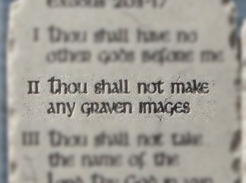
Did you know that making graven images is not illegal under American law?
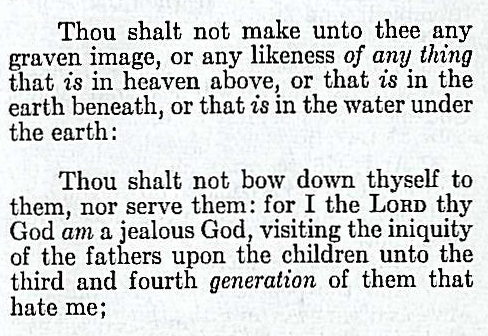
Exodus 20:4-5
Do you know that the second commandment violates the First Amendment guarantee of freedom of speech?
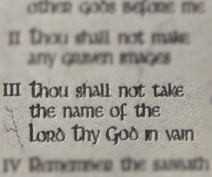
Did you know that taking the “lord’s name” in vain is not illegal under American law?
Do you know that this commandment also violates the freedom of speech?
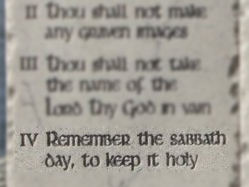
Did you know that failing to worship on the Sabbath is not illegal under American law? Do you know that our Bill of Rights guarantees freedom of religion?
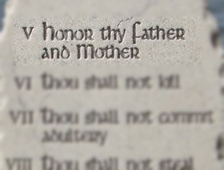
Did you know that it is not illegal to dishonor parents under American law?
Although respect and honor are good ideas, especially within a family, there is no American law that requires it.
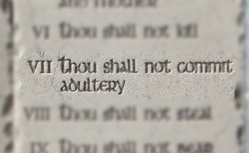
Did you know that adultery is not illegal under federal law?
Although adultery is a serious matter with social and moral consequences, it is not (and should not be) a federal crime in the United States.
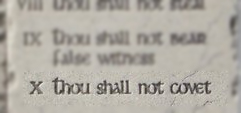
Did you know that it is not illegal to “covet” your neighbor’s property under American law?
(This commandment, if enforced, would undermine our entire system of free enterprise!)
If American law is based on Hebrew scripture, why are 70% of actions forbidden by the Ten Commandments legal in the United States?
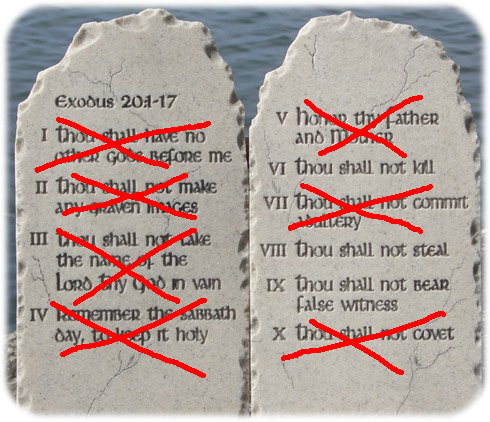
Why will no officer of the law arrest you for any of these acts that were clearly prohibited by the ancient Israelites?
Could it be that American law is based on something else?
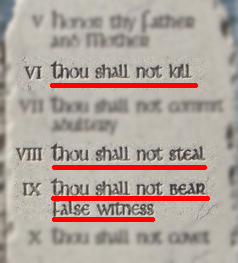
Did you know that only three of the Ten Commandments have any relevance to modern American law? Did you know that these three humanistic precepts existed long before the ancient Israelites claimed the copyright?
Did you know that American law allows for mitigating circumstances, degrees of homicide, self defense, while the Ten Commandments do not? Did you know that telling a lie is generally not illegal under American law (except in proscribed circumstances such as perjury and truth in advertising)?
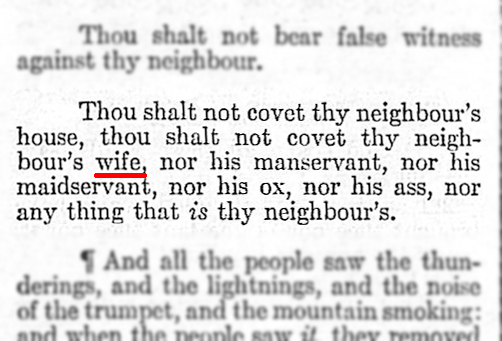
Exodus 20:17
Did you know that the Tenth Commandment insultingly lumps women with property, along with houses, slaves, and animals?
——————————————————————————-
19th Amendment
to the Constitution
1920
The right of citizens of the United States to vote
shall not be denied or abridged by the United States
or by any State on account of sex.
——————————————————————————-
If American law is based on the Ten Commandments, why are women legally equal with men in this country?
Did you know that the Supreme Court, following the Constitution, has declared
that the Ten Commandments are “undeniably a sacred text” (which may not be posted in public schools)?
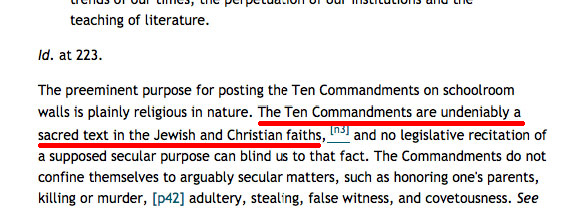
Wording from Stone v. Graham, 1980
Did you know that no U.S. Supreme Court decision has ever been based on the Ten Commandments?
Did you know that the Supreme Court decides whether an action or law is constitutional or unconstitutional, not whether it is biblical or unbiblical?
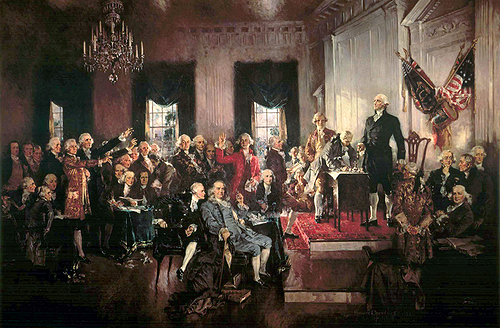
Scene at the Signing of the Constitution of the United States, by Howard Chandler Christy,
East Stairway, U.S. House of Representatives, U.S. Capitol Building.
Did you know that none of the U.S. founding documents mentions the Ten Commandments?
Did you know that during the Constitutional Convention when our secular Constitution was adopted, the Ten Commandments were not mentioned once?
Did you know there was no formal prayer at the Constitutional Convention?

Then What is the basis of American law?
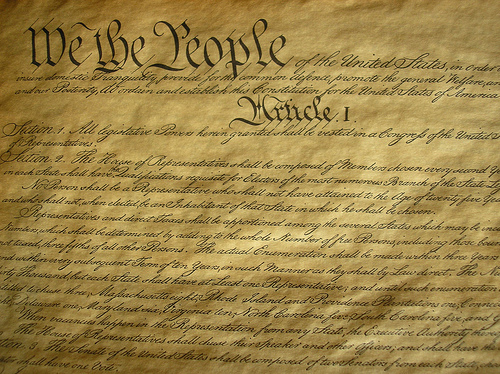
Did you know that the basis of American Law is the U.S. Constitution, not the Ten Commandments or any religious teaching?
——————————————————————————-
First Amendment
to the Constitution
Congress shall make no law respecting an establishment of religion,
or prohibiting the free exercise thereof;
or abridging the freedom of speech, or of the press;
or the right of the people peaceably to assemble,
and to petition the Government for a redress of grievances.
——————————————————————————-
Did you know that the United States Constitution–the basis of American law–is a completely godless document?
Do you know that the only references to religion in the Constitution are exclusionary?
——————————————————————————-
U.S. Constutition, Article VI, paragraph 3
. . . no religious test shall ever be required as a qualification
to any office or public trust under the United States.
——————————————————————————-
Did you know that the U.S. Constitution is not based on a king, deity, goddess, lord, monarch or sovereign authority?
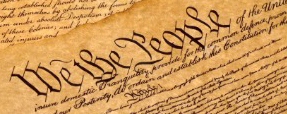
Did you know that the sovereign authority of the U.S. Constitution is “We, the people”?
Did you know that the “consent of the governed” (mentioned in the Declaration of Independence) is an anti-biblical concept?
Did you know that our secular Constitution is what makes the United States truly great?
References & NOTES
- Religious Symbols in the U.S. National Capitol
- Symbols of law at the Supreme Court
- Statues of Contemplation of Justice and Authority of Law
- Inner door, as described by guides at the Supreme Court: One report of the guides’ remarks, told by a surprised pastor who visited the building, appears here.
- Western Pediment
- Courtroom Friezes: North and South Walls
- Courtroom Friezes: East and West Walls
- Eastern Pediment
Fasces
The term “fascism” derives from fasces, which represented “strength through unity,” because it is harder to break a bundle than a single stick.
Emperor Julian
The Roman emperor Julian (nicknamed “Julian the Apostate”), pictured on the bronze door to the Supreme Court, was a pagan who tried to outlaw Christianity.
Penalty for working on the sabbath
“Six days shall work be done, but on the seventh day there shall be to you an holy day, a sabbath of rest to the Lord: whoseoever doeth work therein shall be put to death. Ye shall kindle no fire throughout your habitations upon the sabbath day.” (Exodus 35:2) For the chilling application of this law, see Numbers 15:32-36, where a man who picked up sticks on the sabbath was stoned, “and he died; as the Lord commanded Moses.”
“Consent of the Governed” antibiblical
“There is a way that seems right to a man, but its end is the way to death.” (Proverbs 14:12)
“Trust in the Lord with all your heart, And lean not on your own understanding;In all your ways acknowledge Him, And He shall directyour paths. Do not be wise in your own eyes.” (Proverbs 3:5-7)
“Let every soul be subject unto the higher powers. For there is no power but of God: the powers that be are ordained of God.” (Romans 13:1)
“The LORD has established His throne in the heavens; And His sovereignty rules over all.” (Psalm 103:19)
(Prepared by Dan Barker for the Freedom From Religion Foundation, August 2012.)

